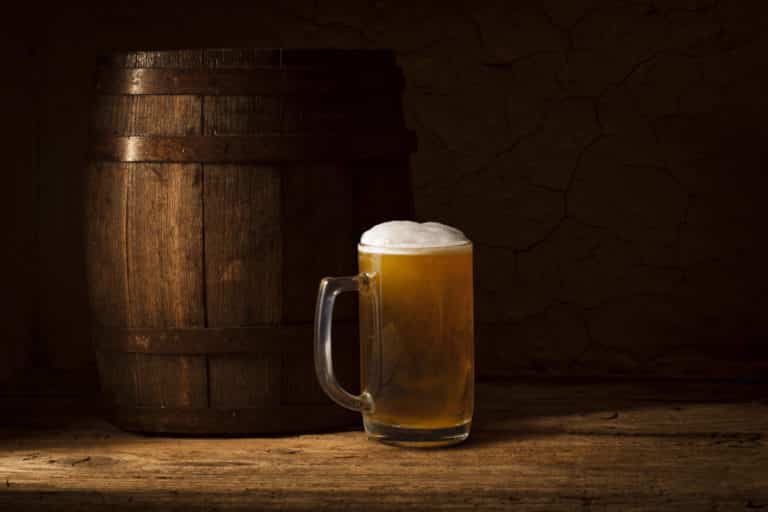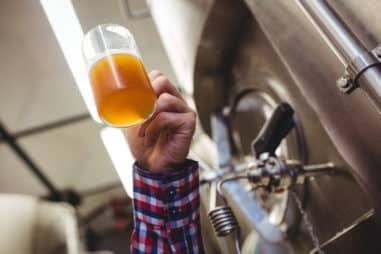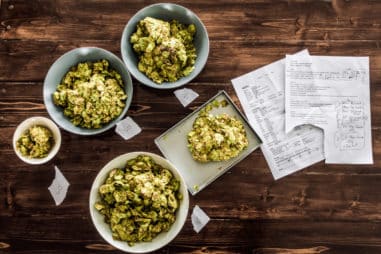Not everyone agrees it should be done. Some brewers champion it, haters ignore it, and professionals work around it. If you want to find out the facts of fermentation, read them here in this stack of information.
What Is the Purpose of Secondary Fermentation?
What the avid beer drinker wants is mature beer. One way you achieve this maturity is through Secondary Fermentation.
Mature beer is a beer that has a uniform, consistent, and smooth flavor profile. No surprises like off-flavors. It is an opportunity for malt, hops, yeast, and the occasional additive to get into balance.
You also get one step closer to a visually stunning clear beer.
How Important Is Secondary Fermentation?
To the basic brewer, Secondary Fermentation is important when aging beer for a long time. This procedure avoids beer tasting like burnt rubber from overexposure to dead yeast. This phase of brewing is more of a transfer than fermentation.
Secondary Fermentation is also important for conditioning your beer. And if you want to reuse your yeast, the time to take it is during the transfer.
What Is the Benefit of Secondary Fermentation?
There are specific scenarios when Secondary Fermentation shines. These are most of the common benefits it provides:
- Clear Beer. If you don’t like hazy beers, this is a step that works.
- Extra Flavor
- You can do dry hopping and fruit infusions at this point.
- You can chuck in some oak chips to emulate oak-barrel fermentation.
- Flatten Flavor Spikes.
- This fermentation smoothens flavor peaks that are out of place.
- Overly strong taste profiles get mellower.
Does Secondary Fermentation Increase Alcohol?
Fermentation should mostly be finished before you go into Secondary Fermentation. This is the reason why you would get some increase in alcohol. But, it is in the order of fractions of a percent.
It is not normal to plan to increase alcohol levels during Secondary Fermentation. If you have no choice but to do it, there is likely something wrong in the processes leading up to it. If you start adding sugars for conversion at this point, the chance of a flavor imbalance is high.
Do You Have to Do a Secondary Fermentation?
Run-of-the-mill basic beers do not benefit much from Secondary Fermentation. This is because they do not need long fermentation times. On the other hand, some of the beer styles that benefit the most are:
- Lagers,
- Hoppy Beers,
- Strong Beers (High ABV, High Gravity), and
- Specialty Beers.
Should I Do a Secondary Fermentation?
If you want to do Secondary Fermentation for the sake of it, you can. The least positive benefit you will get is a clearer beer. Of course, this is assuming you mitigated the downsides like oxidation and contamination.
However, some applications of Secondary Fermentation change the recipe. Imagine a recipe that is characteristically cloudy. Why in the world would you go and clarify that beer? Visualize wheat beers that are crystal clear. That makes no sense. Therefore, do not go doing a “secondary” without considering the recipe.
Can You Skip Secondary Fermentation?
Experts associate Secondary Fermentation with transferring to a secondary fermenter. So with that mindset, you can skip it for the following reasons:
- You will homebrew simple and standard recipes,
- you want cloudy beer,
- you have no plans for dry hopping,
- you are not going to age the beer, and
- when the risk of oxidation and contamination is greater than the reward.
You can also skip Secondary Fermentation if you use a conical fermenter. It is what the pros use to avoid all the disadvantages of using multiple vessels.
When Should I Do Secondary Fermentation?
Once you have confirmed that active fermentation is done, that is the time you can go to the next stage. Visually, you will notice obvious signs like:
- Yeast clumping and dropping to the bottom of the vessel.
- Significant reduction in your airlock’s bubbling.
When these events occur, you confirm a completed active fermentation through hydrometer readings. If they are in the range of the recipe’s target and are constant over several days, that is the green light.
When Should I Start Secondary Fermentation?
There is no consensus on the optimal timing for Secondary Fermentation. From the point when you observe reduced bubbling of your airlock, 2 to 6 days is a benchmark for ales. For lagers, 4 to 10 days. Always remember to make the validation via hydrometer.
Do Lagers Need Secondary Fermentation?
Because Lagers need a cold environment, they need a longer time in fermentation. Since Secondary Fermentation is good for long fermentations, you will gain from doing it.
Remember that by moving to the secondary fermenter, you leave the bad stuff behind. The kind of stuff that leaches unpleasant flavors the longer they stay.
Is Secondary Fermentation Necessary for IPA?
Secondary Fermentation is a calm period that is perfect for hoppy beers like IPAs. It allows IPAs to take in all the wonderful hoppy aromas and flavors without much effort. If you were to dry hop during active fermentation, retaining the hoppy goodness is tough. The outward pressure of the gasses takes with them a lot of stuff, including hop essence.
What Do You Use for Secondary Fermentation?
There are many equipment options for the homebrewer to do Secondary Fermentation. You can use the conventional buckets and carboys. There are also options for brewers strapped for cash. And, there are options for those who want to throw cash at their problems. There is something for everyone.
Can I Use a Plastic Bucket for Secondary Fermentation?
Plastic Buckets have limited use in Secondary Fermentation. This is because they are prone to taking in air that causes unwanted oxidation. If you are going to use it as a secondary fermenter, you should use it within a month. Most experts advise not using it if possible. It all depends on your risk appetite though.
Why Use a Carboy for Secondary Fermentation?
Carboys are the preferred fermenting vessel for Secondary Fermentation. When you select the size and material well, you can get a good fermentation going. You would typically use a 5-gallon carboy for a 5-gallon batch. It has the least amount of headspace to minimize contact with air.
Can You Use a Plastic Carboy for Secondary Fermentation?
Glass Carboys are great as a secondary fermenter but Plastic ones are almost there. This is because plastics are not impervious to oxygen. You get the nice headspace but fall short in airtightness. That is not to say that you should not use it. It is a better choice than a bucket in certain scenarios.
Can I Use a 6 Gallon Carboy for Secondary Fermentation?
If you have a 5-gallon brew and you use a 6-gallon Carboy for Secondary Fermentation, it is not bad but it could be better. You are unintentionally creating opportunities for oxidation. And, it is not a very efficient use of resources. If you have a 6-gallon brew paired with a 6-gallon Carboy, now that is more like it.
Can You Do Secondary Fermentation in a Keg?
If a Keg is the only other vessel you have, you can use it for Secondary Fermentation. You just need to take more precautions than normal. If you did not confirm active fermentation completion, you might end up with an explosion.
You can do the following general options when racking to a keg:
- Use pressurized carbon dioxide (CO2) to relocate the beer using a closed system.
- Purge your receiving keg with CO2, and use a racking cane or siphon to move the beer from fermenter to keg.
- Purge your receiving keg with CO2, and move the beer from the fermenter’s spigot via a hose.
Which method you choose will depend on the particular attributes of your keg.
Secondary Fermentation in a Pressure Barrel
You can use Pressure Barrels for Secondary Fermentation, no problem. You do not even need an airlock because you can just release the pressure on the valve manually if need be. This is on top of the automatic pressure release safety mechanism. You can use the same methods you would use for kegs when transferring from the primary fermenter.
Secondary Fermentation in a Tank
If you are planning on brewing beer on the scale of small brewers, you can get stainless steel tanks. There are also the pro-level conical tanks that can handle all fermentation stages. Some of these tanks have variable volumes but it would seem wasteful to brew 5 gallons in a 31-gallon tank. Their capacities are normally a fraction or a multiple of a US beer barrel (31 gallons or 117 liters).
There is also the option of “Fusti” tanks used in the wine industry. They can replace glass carboys and are available in a plethora of sizes.
Secondary Fermentation in Bottles
Secondary Fermentation in Bottles is a different level of fermentation. There is a difference between a mass of yeast’s action versus the cramped yeast in a bottle. Brewers call the unique fermentation in bottles “bottle conditioning.”
The goal of bottle conditioning tends to focus more on carbonation. It also adds some unique flavor profiles to beer which some beer styles exploit, in a good way.
Does Secondary Fermentation Need to Be Airtight?
If you have Secondary Fermentation plans that span several months, airtightness is critical. Indefinite times allow for more chances for air to contaminate the beer. This increases horrible flavors and beer staleness.
However, for short fermentation of less than a month, your setup need not be perfect. You can get away with some shortcuts. Just stick to your sanitation procedures religiously. There is also food-grade Vaseline you can use as a quick touch-up to potential leak sites.
Do I Need an Airlock for Secondary Fermentation?
Keep in mind that Secondary Fermentation is not supposed to be wildly active. And hopefully, before going into the secondary, you confirmed the constant hydrometer readings. If so, airlocks should not do very much.
But, if you plan to add fermentable materials like fruit, yeast activity can start again. In that case, airlocks will save you from a world of pain.
How to Do Secondary Fermentation at Home
Here is a quick outline of how to go about doing a Secondary Fermentation:
- Sanitize Your Vessels. The long wait can easily turn a simple mistake into wild microbes crashing the party and taking over.
- Transfer Beer by Siphoning. It is a slow and tedious process to set up hoses, racking canes, and all sorts of apparatus, but it sure beats stale beer. You should refer to your fermenter’s details to choose the right method for making transfers.
- Know the Beer Style. Rules-of-thumb are great and all, but the correct timings come from the actual recipe. You will need to check your brewing kit’s instructions or surf homebrewing sites for this one.
Do You Add Sugar to Secondary Fermentation?
You can add Sugar in Secondary Fermentation, but it is a bad sign. The risk of making your beer sweeter than it should be is there. There aren’t really good sources of reference on how to go about it but when push comes to shove try:
- Adding Simple Sugars. Brewer’s Crystals, corn sugar, table sugar, honey, etc.
- Adding Malt Extract. Dry or Liquid Malt Extract.
This step is not something that you should take lightly. The exact figures you will need to study beforehand. Or, you can use online calculators.
Do You Add More Yeast for Secondary Fermentation?
Like adding sugar, adding more yeast for Secondary Fermentation indicates issues. Normally, you would add yeast if the fermentation stalled. You do not add dry yeast directly, rather, you would whip up a starter culture. Pitching them straight away will result in shock. You should expose the starter to a small volume of the wort so they can get used to the environment.
Does Temperature Matter During Secondary Fermentation?
Varying the temperature during Secondary Fermentation has the following effects:
- Temperatures above recommendation will increase the “cleaning” rates of the yeast. Off-flavors like those from diacetyl get reduced.
- Lower temperatures tend to make the process longer than it should be. It is best to stick to the optimal numbers for your particular recipe.
Going overboard in either direction just stops the process dead.
What Temperature Should Secondary Fermentation Be?
The general temperatures that are common for Secondary Fermentation are:
- Ales: 62 to 75°F (17 to 24°C). This range is about the same as primary fermentation temperature.
- Lagers: 40 to 60°F (4 to 15°C). Some brewers use the upper end of the range to speed up the “cleaning” process. But do not go beyond 48 hours above 60°F (15°C).
How Long Does Secondary Fermentation Take for Beer?
Some brewing kit makers like Midwest Supplies have data on Secondary Fermentation durations. The preferred time a secondary should run is about two weeks. For the parent classes of beers, refer to the table below.
| Parent Beer Class | Ale | Lager |
| Light | 1 to 2 weeks secondary | 2 months secondary |
| Amber | 2 to 3 weeks secondary | 3 to 4 months secondary |
| Dark | 3 to 4 weeks secondary | 9 months secondary |
| High Alcohol | 9 to 12+ months secondary | 9 to 12+ months secondary |
You can conclude from the data that malty and high-alcohol beers need more time to condition the beer.
How Long Does Secondary Fermentation Take in a Bottle?
Secondary Fermentation in a bottle still takes about one to two weeks. This depends on what you are trying to achieve for the recipe. If it is just carbonation, then the bare minimum is okay.
However, always do taste tests for every time interval. There might be hints of sulfur that any remaining yeast should clear in two weeks. A good practice is to test a bottle every week or so to see if the flavors work for you.
How Long Should You Leave Fruit in Secondary Fermentation?
A week of extracting flavor from fruit is enough in a secondary fermenter. Doubling the duration of soaking fruit does not really double the flavor. One of the homebrew methods of adding fruit is by:
- chopping up the desired fruit,
- place it inside your secondary fermenter,
- seal the vessel, and then
- siphon the beer from the primary fermenter.
If you want to use the method of the Lindemans brewery, they have a simple process of making their fruit beers. They just blend in some fresh juice with their finished beer and macerate it for three days.
How Do You Know When Secondary Fermentation Is Complete?
You will know when Secondary Fermentation is complete in a week. It can also go as long as a year. It really depends on your recipe and taste tests. Visually the beer becomes clearer even more so than when in the primary fermenter.
For your palate, conditioning shaves off any roughness and off-flavors. But, hoppy, fruity, and floral flavors can wane over time. This is something to balance when it comes to specific recipes.
When to Stop Secondary Fermentation
Ideally, you do not need to go beyond the recommended durations for fermentation. You can stop at that point. There is some good data available for the homebrewer online so you won’t get lost.
However, say you forgot about your light ale in the fermenter for six weeks. Once you start bottling, expect carbonation not to go so well. You might need to send in some fresh yeast. You might ruin some good beer so check it first. If carbonation is a big deal, you can just force carbonate it with a shot of CO2.
How Do I Stop Secondary Fermentation?
If you have absolutely decided fermentation of any kind should stop, you can:
- Chill Your Beer to refrigerator temperature which is at or below 40°F (4°C).
- Chuck in Potassium Sorbate. In layman’s terms, this is a yeast poison of sorts.
- Filter Your Beer with a 0.5-micron filter. You need to be careful with this one as it also takes out flavors and aromas.
- Heat Your Beer to 140°F (60°C). Brewer’s yeast terminates at this temperature.








